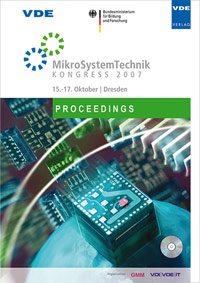Vitality and Functionality of Pancreatic Islets and Multicellular Spheroids after Cryopreservation in Micro-Cryosubstrates with Automatic Addition of Cryoprotectants
Conference: MikroSystemTechnik - KONGRESS 2007
10/15/2007 - 10/17/2007 at Dresden, Germany
Proceedings: MikroSystemTechnik
Pages: 4Language: englishTyp: PDF
Personal VDE Members are entitled to a 10% discount on this title
Authors:
Katsen-Globa, A .; Schulz, J. C.; Ehrhart, F.; Zimmermann, H. (Abteilung Kryobiophysik & Kryotechnologie, Fraunhofer-Institut fuer Biomedizinische Technik, Ensheimerstr. 48, 66386 St Ingbert, Germany)
Feilen, P.; Weber, M. M. (Schwerpunkt Endocrinologie und Stoffwechselerkrankungen, Medizinische Klinik and Poliklinik, Universitätsklinik Mainz, 55131 Mainz, Germany)
Wiedemeier, S.; Metze, J. (Institut fur Bioprozess- und Analysenmesstechnik e.V., Ltr. Fachbereich Bioprozesstechnik, Rosenhof, 37308 Heilbad Heiligenstadl, Germany)
Abstract:
Advances in stem cell therapies, regenerative medicine, tissue engineering, chemotherapy of tumours etc. need adequate cryopreservation of living multicellular systems that recover structure and function after thawing. However, heterogeneity of multicellular spheroids and the resulting temperature gradients during freezing make a cryopreservation of those systems very complex. For this goal we have developed miniaturized cryosubstrate and microsystem based cryoprotectants dispenser. Here, we investigate the recovery of multicellular systems after cryopreservation. "Hanging drops" and free spheroids from L929 mouse fibroblasts and PC-3 prostatic cancer cells and rat pancreatic islets were cryopreserved in micro-cryosubstrates with automatic DMSO addition (5% DMSO by spheroids, 7% and 14% DMSO by islets). After thawing, the recovery and functionality of multicellular systems was studied with fluorescence vitality test, scanning electron microscopy (SEM) and block-face SEM, tested for stimulated insulin secretion and immunostained for detection of pancreas hormenes. Our results show that spheroids and pancreatic islets can be successfully cryopreserved in micro-cryosubstrates with automatic DMSO addition. More than 80% of L929 and PC-3 hanging drops spheroids and about 70% of pancreatic islets were vital. SEM and block-face SEM confirmed the integrity and preservation of cell surface and ultrastructure of both spheroids and islets. Successful preservation was correlated with increased insulin secretion of pancreatic islets. The hormone expression in cryopreserved islets was comparable with a control. Development of new cryobiological devices based on micro-system technology has started using these results.


